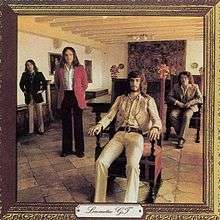Locomotiv GT (album)
Compared to other Hungarian music albums of the time, the sound of Locomotiv GT was heavier (most reminiscent of Éjszakai országút, released by Omega in 1970), and with the exception of "Ezüst nyár", the album lacked so-called hits. That was the result of a conscious decision made by the group; they intended to play high-quality rock music resembling more to that of made by English and American groups. Unlike albums released by LGT in the second half of the 1970s, the instrumentation of Locomotiv GT is somewhat simple, the saxophone being the only "exotic" instrument. The music is built around the virtuoso guitar playing of Barta, and the masterful organ playing of Presser; in addition, Frenreisz plays his bass more powerfully than most of his Hungarian peers, and the drumming of Laux is also worth to mention. The style of the songs does not really fit in with the typical Hungarian pop music of the time; that is, it is more mature, although it cannot be called progressive rock in its traditional sense. Improvisation, showing the skills of the musicians, was employed more frequently in songs, such as "A Napba öltözött lány", "A tengelykezű félember", and "Hej, én szólok hozzád". The influence of American blues-rock (in "Nem nekem való" and "Royal blues") and jazz (in the somewhat parodic "Sose mondd a mamának") are also evident. Locomotiv GT recorded the album before they played any live concerts together. Gábor Presser later stated that the album was a getting to know each other affair, and that LGT became a real band only by the time they recorded their following album, Ringasd el magad.[1] The lyrics were written by Anna Adamis (the wife of Laux at the time), who provided the lyrics to most Omega songs between 1968 and 1970.
| Locomotiv GT | ||||
|---|---|---|---|---|
 | ||||
| Studio album by | ||||
| Released | December 10, 1971 | |||
| Recorded | Budapest, 1971 | |||
| Genre | Rock, blues-rock | |||
| Length | 42:40 | |||
| Label | MHV (Hungary) Qualiton (Argentina) Capitol Records (U.S. English version) | |||
| Locomotiv GT chronology | ||||
| ||||
Locomotiv GT is the debut album of the Hungarian rock group Locomotiv GT. It was released in December 1971.
Though not a huge success because of its experimental style, Locomotiv GT proved to be a promising debut; their second release, Ringasd el magad, gained more popularity. In 1973 Locomotiv GT was issued in Argentina by Qualiton (not to be confused with the Hungarian label) in the form of a license album. Its cover art was different from the original Hungarian version, but the content was the same.
Track listing
Side One
- "Egy dal azokért, akik nincsenek itt" (Gábor Presser, Anna Adamis) – 5:04
- "A Napba öltözött lány" (Károly Frenreisz, Adamis) – 4:54
- "A kötéltáncos álma" (Tamás Barta, Adamis) – 3:33
- "A tengelykezű félember" (Presser, Adamis) – 4:24
- "Hej, én szólok hozzád" (Presser, Adamis) – 5:45
Side Two
- "Ezüst nyár" (Presser, Adamis) – 3:03
- "Ordító arcok" (Barta, Adamis) – 4:17
- "Sose mondd a mamának" (Frenreisz, Adamis) – 3:49
- "Nem nekem való" (Frenreisz, Adamis) – 4:41
- "Royal blues (Gipszeld be a kezed)" (Barta, Adamis) – 3:06
Personnel
- Tamás Barta – guitars
- Károly Frenreisz – vocals, Fender bass, soprano saxophone, tenor saxophone, flute, guitar
- József Laux – drums, percussion
- Gábor Presser – vocals, organ, piano, vibraphone
- Anna Adamis – lyrics
Production
- Attila Fülöp – engineer
- Dóra Antal – executive producer
- Tamás Féner – photos
- Miklós Mester – cover art
Release history
| Region | Date | Label | Format | Catalog | Notes |
|---|---|---|---|---|---|
| Hungary | 1971 | MHV Pepita | stereo LP | SLPX 17435 | |
| Argentina | 1973 | Qualiton | SQH-2037 | Licensed album issued in Argentina.[2] | |
| United States | 1974 | ABC Dunhill | ABCX-811 | All songs are in English, alternative cover. Released on 8-Track tape as well. | |
| Hungary | 1991 | Hungaroton Mega | SLPM 37528 (91/M-003) | Part of A Locomotiv GT összes nagylemeze box set | |
| 1992 | Hungaroton-Gong | CD | HCD 37528 (92/M-003) |
References
- Interview by Tibor Miklós in the book Keresem a szót, keresem a hangot... (Zeneműkiadó, Budapest, 1977
- LGT discography Archived 2007-12-03 at the Wayback Machine (Accessed on February 14, 2009)